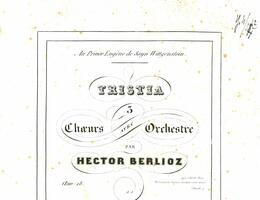Tristia
Version originale pour chœur et piano (1849) : Méditation religieuse – La mort d’Ophélie, ballade
Version révisée pour chœur et orchestre (1851) : Méditation religieuse – La mort d’Ophélie, ballade – Marche funèbre pour la dernière scène d’Hamlet
Published in 1852, the musical trilogy Tristia (op. 18) is a set of individual pieces composed at different times. The first edition of the collection (1849) contains only the choral pieces Méditation religieuse and La Mort d’Ophélie, to which Berlioz added the Marche funèbre pour la dernière scène d’Hamlet in the second version of the work (1852). The Méditation religieuse was a setting of the poem by Thomas Moore “This world is all a Fleeting Show”, translated into French by Louise Swanton-Belloc. The original version of this chorus, entitled “Psalmodie pour ceux qui ont beaucoup souffert et dont l’âme est triste jusqu’à la mort” (Psalmody for those who have suffered greatly and whose soul is sick unto death) and written with an accompaniment of seven wind instruments, later replaced by orchestra, was composed in Rome on 4 August 1831, a day when the composer was “dying of spleen” (letter to Hiller). Dedicated to Marie d’Agoult, the ballade La Mort d’Ophélie, to a text by Ernest Legouvé inspired by Act IV of Shakespeare’s Hamlet, was composed in 1842 for solo voice (soprano or tenor) and piano. The composer revised the work to produce a version for chorus and orchestra for a Shakespeare evening which was to have taken place at Covent Garden in 1848. Lastly, the Marche funèbre pour la dernière scène d’Hamlet was composed in 1844 for a planned performance of Hamlet at the Odéon Theatre, but the piece was not completed until 1848. Never performed during the composer’s lifetime, this wordless chorus, remarkable for its instrumentation and harmonic progressions, became a staple of Parisian symphonic concerts under the Third Republic.

